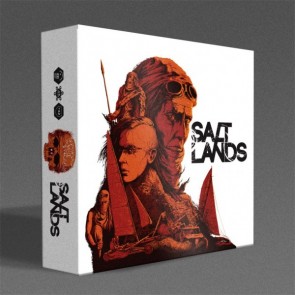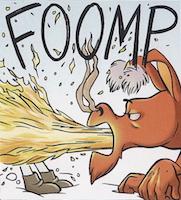Saltlands – Sail Through the Desert! is a recently published boardgame from Antler Games for 1 to 6 players and set in a Mad Max-style future.
Saltlands – Sail Through the Desert! is a recently published boardgame from Antler Games for 1 to 6 players and set in a Mad Max-style future. Although it was a Kickstarter, I only learned of the game shortly after it shipped, and managed to pick up the base game from a reseller on Amazon. I also got the Lost in the Desert expansion from another reseller on eBay.
The Saltlands are a former inland sea which dried up during an unspecified apocalypse. There are some small settlements on the edge of the Saltlands which are overrun by ruthless raiders at the start of the game. Each player controls a refugee character who is fleeing the raiders and chasing rumors of other settlements across the wasteland.
Saltlands has strong visual appeal. The starkness of the salt is seen throughout the game, on the box covers, the white space on the cards, the salt hexes on the map tiles, and the artwork on the back of the character cards. The art is crisp and evocative, and nearly realistic. The closest comparison I can make would be a non-porno Milo Manara. The characters are depicted on standees, while the raiders are all represented by small tan plastic miniatures of their vehicles.
Each player starts with an over-sized character card, plus some playing cards representing a spear, a water skin, a unique item, and a landsail. Each character has a unique ability and their unique item, and these small differences can have a significant impact on your strategy. For example, the Scout gets a movement bonus if he is driving a gas-powered vehicle, and can use his binoculars to reveal even distant terrain tiles. The Scientist is constantly tinkering, so he gets a free card draw each turn and can use his water distiller to retrieve water cards from the discard pile.
The landsail is like a small sail boat on wheels, with some room for cargo or passengers. Movement with a land sail is very tactical, because it moves faster when travelling at an angle ahead of the wind. And movement against the wind is only possible by tacking back and forth at angles. The wind periodically changes direction and force, causing land sails to move faster or slower. The land sails travels over both salt and sand dunes, but not through rocky terrain.
The raiders all drive gas-powered vehicles, which come in six varieties. Some gas-powered vehicles can’t handle sand dunes, but they all drive well on rocky terrain. Some of the gas-powered vehicles also have armor, and all are generally slower than the land sails. If you kill a raider, you get to draw some loot cards, and you can potentially abandon your current vehicle and drive off in the raider vehicle. A wounded raider is flipped on its side, which would work better with cardboard chits, but the minis are helpful for recognizing the different types of raiders.
There is a lot of open information in the game. When a new terrain tile is revealed, it is immediately stocked with some random face-up tokens representing allies, card draws, rumors, and victory cards. The four starting land tiles are also stocked with these tokens. Players scramble to grab those tokens while fighting or fleeing from raiders. The rumor tokens cause the rumor markers to migrate about the map, possibly revealing new terrain tiles and eventually a way to escape to safety. The victory cards represent items needed to buy a way into one of those safe havens, though these items could also get used during the game by desperate players.
Certain game elements do a great job of connecting mechanics to the setting. Water allows you to refresh (“untap”) characters for additional actions. Gas can be used to burn enemies or to increase your movement with a gas-powered vehicle. Cargo and passengers reduce your hand size.
Combat is brutal and unforgiving, which suits the theme of Saltlands. If it is a player’s turn, that player can potentially attack raiders. If it is a raider turn, only one type of raiders can attack. A player attack consists of tapping a character and a weapon card to generate a fixed amount of damage. The damage is reduced by raider armor, and any remaining damage kills first the raider passenger and then the raider driver. Raider attacks are similar, except that their damage is determined by flipping a raider activation card that shows their attack value and movement modifier for the turn. Some attacks are armor-piercing, which means that your only defense is using medical supplies or losing passengers.
There are three levels of difficulty and four modes of play. Medium and Hard difficulty levels unlock additional spawning locations for raiders, and restrict or disallow re-spawning your dead character. The four modes of play are: solitaire, co-operative, “classic”, and competitive. Classic mode allows players to cooperate, compete, or even betray one another. Solitaire mode is nine turns long instead of the usual six.
At any level of difficulty, winning is hard, because you don’t know where to go to win until all you have gone through all the rumor cards. To play rumor cards, you must grab rumor tokens. Grabbing rumor tokens means that you are giving up chances to attack raiders or gain cards or allies. Once you find where to go, you can’t win until you have also cleansed that map tile of all raiders. And you have six turns to accomplish all these things.
The game components strive for language independence. The cards and tokens share an alphabet of icons, but they are mostly intuitive. At least 50% of nearly every page in the rulebook is a picture that helpfully demonstrates a relevant aspect of the game. That said, I think that it would be tough to just jump into a game of Saltlands without carefully reading through the rules at least once.
The expansion adds a modest amount of everything: more cards, more terrain tiles, more tokens, and more raiders. It also allows for seventh turn to the game, with a larger map setup. Most importantly, the expansion has useful cheatsheets and six new characters. With a little effort, all the expansion components can fit into the base game box.
Saltlands is a good game that offers a distinctive take on a Mad Max-style setting. It has the right mix of chase and combat, and occasionally offers up difficult tactical and strategic choices. However, the wealth of open information on the table can really slow the game down with inexperienced players, and that slower pace partially undermines the theme. Even experienced players will occasionally need to pause to figure out which way a given raider will move to attack the nearest target. And the changing wind makes movement a minor puzzle each turn unless a player acquires a gas-powered vehicle. All that adds up to a fair amount of downtime. In co-op mode, the downtime is either longer or shorter, depending on how you feel about kibitzing during another player’s turn.
If you enjoy AmeriTrash games and Mad Max movies, you will appreciate Saltlands – Sailing Through the Desert. Unfortunately, Antler Games is based in Budapest, so you may be looking at expensive shipping unless you find a seller on eBay or Amazon.
 Games
Games How to resolve AdBlock issue?
How to resolve AdBlock issue? 




























